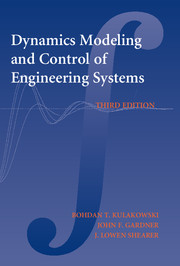Book contents
- Frontmatter
- Contents
- Preface
- Dynamic Modeling and Control of Engineering Systems
- 1 INTRODUCTION
- 2 MECHANICAL SYSTEMS
- 3 MATHEMATICAL MODELS
- 4 ANALYTICAL SOLUTIONS OF SYSTEM INPUT–OUTPUT EQUATIONS
- 5 NUMERICAL SOLUTIONS OF ORDINARY DIFFERENTIAL EQUATIONS
- 6 SIMULATION OF DYNAMIC SYSTEMS
- 7 ELECTRICAL SYSTEMS
- 8 THERMAL SYSTEMS
- 9 FLUID SYSTEMS
- 10 MIXED SYSTEMS
- 11 SYSTEM TRANSFER FUNCTIONS
- 12 FREQUENCY ANALYSIS
- 13 CLOSED-LOOP SYSTEMS AND SYSTEM STABILITY
- 14 CONTROL SYSTEMS
- 15 ANALYSIS OF DISCRETE-TIME SYSTEMS
- 16 DIGITAL CONTROL SYSTEMS
- APPENDIX 1 Fourier Series and the Fourier Transform
- APPENDIX 2 Laplace Transforms
- APPENDIX 3 MATLAB Tutorial
- APPENDIX 4 Simulink Tutorial
- Index
7 - ELECTRICAL SYSTEMS
Published online by Cambridge University Press: 05 June 2012
- Frontmatter
- Contents
- Preface
- Dynamic Modeling and Control of Engineering Systems
- 1 INTRODUCTION
- 2 MECHANICAL SYSTEMS
- 3 MATHEMATICAL MODELS
- 4 ANALYTICAL SOLUTIONS OF SYSTEM INPUT–OUTPUT EQUATIONS
- 5 NUMERICAL SOLUTIONS OF ORDINARY DIFFERENTIAL EQUATIONS
- 6 SIMULATION OF DYNAMIC SYSTEMS
- 7 ELECTRICAL SYSTEMS
- 8 THERMAL SYSTEMS
- 9 FLUID SYSTEMS
- 10 MIXED SYSTEMS
- 11 SYSTEM TRANSFER FUNCTIONS
- 12 FREQUENCY ANALYSIS
- 13 CLOSED-LOOP SYSTEMS AND SYSTEM STABILITY
- 14 CONTROL SYSTEMS
- 15 ANALYSIS OF DISCRETE-TIME SYSTEMS
- 16 DIGITAL CONTROL SYSTEMS
- APPENDIX 1 Fourier Series and the Fourier Transform
- APPENDIX 2 Laplace Transforms
- APPENDIX 3 MATLAB Tutorial
- APPENDIX 4 Simulink Tutorial
- Index
Summary
LEARNING OBJECTIVES FOR THIS CHAPTER
7–1 To recognize the A-, T- and D-type elements of electrical systems.
7–2 To develop the mathematical equations that model the dynamic behavior of RLC electrical circuits.
7–3 Develop the equations that describe the dynamic behavior of RLC circuits with time-varying capacitors and inductors.
7–4 Analyze simple operational-amplifier circuits.
INTRODUCTION
The A-type, T-type, and D-type elements used in modeling electrical systems, which correspond to the mass, spring, and damper elements discussed in Chap. 2, are the capacitor, inductor, and resistor elements.
A capacitor, the electrical A-type element, stores energy in the electric field induced in an insulating medium between a closely spaced pair of conducting elements, usually plates of metal, when opposite charges are applied to the plates. Capacitance is a measure of the ability of a capacitor to accept charge and hence its ability to store energy. It occurs naturally between the conductors of a coaxial cable, between closely spaced parallel cables, and in closely packed coils of wire. In these cases the capacitance is distributed, along with resistance and inductance, along the line, and the analysis of such situations is beyond the scope of this text. However, in some cases the resistance and inductance are negligible, making it possible to use a lumped-capacitance model. More frequently, specially designed off-the-shelf capacitors are used that have negligible inductance and series resistance.
- Type
- Chapter
- Information
- Dynamic Modeling and Control of Engineering Systems , pp. 168 - 197Publisher: Cambridge University PressPrint publication year: 2007

